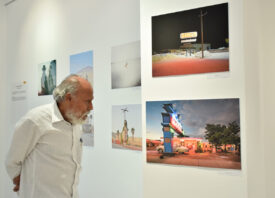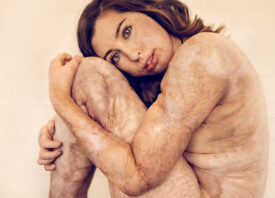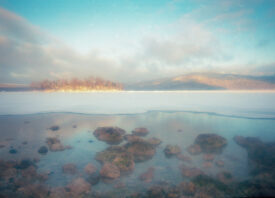Search this site
12 Must-See Exhibitions at the Indian Photo Festival, Hyderabad

The Indian Photo Festival in Hyderabad, South Asia’s leading Photography Festival, is back for its 7th edition, with an all-star lineup of speakers, workshops, screenings, events, and exhibitions from some of the most inspiring voices in photography, from legendary photojournalists like Prashant Panjiar to emerging talents covering hidden and untold stories.
With artist talks from Roger Ballen, Sharbendu De, Martin Parr, Arati Rao, Rut Blees Luxemburg, Ruhani Kaur, and more, plus portfolio reviews with National Geographic, this year’s IPF celebrates the power of photography to influence change, even during unprecedented times. The festival runs from Friday, November 19th through December 19th, 2021, in hybrid format, including physical and digital exhibitions.
Together, the exhibitions at IPF cover some of the most important issues of a generation, from conflict to COVID-19. At the same time, we might also discover reminders of hope, such as tender moments shared by the LGBTQ+ community in Bangladesh or the work of an engineer battling the devastating effects of climate change. Some photographers delve into personal stories with universal significance, tracing the ties of love and family through the generations.
Here are just twelve exhibitions you can’t miss at this year’s Indian Photography Festival. Of course, we’ve only scratched the surface, so be sure to check out the IPF website for the full schedule of events and shows.

That Which Is Unseen by Prashant Panjiar
Prashant Panjiar has worked in photojournalism for more than 30 years, covering urgent stories relating to health, education, conflict, and beyond. This exhibition takes us through his life and career in photography, guided by his own words and images. The show coincides with a book of the same name, published by Navajivan Trust.

debts to repay. © Chinky Shukla
A curse in disguise: Pokhran Nuclear Test by Chinky Shukla
In this exhibition, the documentary photographer Chinky Shukla tells the story of the people living in the villages of Khetolai, Loharki, and Chacha in India. In 1998, residents were evacuated from their homes as part of a nuclear test. Soon after, they felt the earth shake and watched a massive cloud of dust rise over the Pokhran firing range.
Once the nuclear test was over, they returned home to find burst water tanks and contaminated farmland. Even now, cases of cancer, miscarriage, cerebral palsy, and more health problems are being reported.
“Nearly 20 years after the Smiling Buddha mission, the villages near Pokhran have joined a tragic global circle of residents of nuclear test sites that grapple every day with the aftermath of radiation,” Shukla writes. “The test got India the world’s ear, but the residents of these villages are still waiting to be heard.”

Remember Me by Divya Cowasji
Merging objects left behind and stories passed on between the generations, Divya Cowasji traces her family history in her series Remember Me. The project focuses on the women in her family, including her mother, grandmother, great aunt, and great-grandmother. “Though specific to my Parsi-Irani-Indian heritage, this is also a universal tale of family and inter-generational connection, the desire to be remembered, and the ultimate faltering and failing of human memory,” the artist writes.

“After his death, Iman was assigned to a widows’ house. She called from there but could not talk much – someone was staying behind her all the time. Then through the word of mouth, we heard that she had been imprisoned.
There has been silence since 2017. To be honest, no one expected that fate would turn out this way. Our daughter studied acting and loved to dance. She has always been a very sensitive girl. Now she has been in prison for the 4th year, and we have forgotten what she looks like.” © Sergei Stroitelev
The Strongest Bond by Sergei Stroitelev
This exhibition by Sergei Stroitelev is devoted to Chechen and Dagestan mothers whose daughters have gone missing or been imprisoned in former Islamic State territories. This story began in 2015, when young men from Chechnya and Dagestan, given promises from recruiters, started moving to Mosul and Raqqa. Their families followed.
“2017 was marked by campaigns to clear the above territories from illegal gangs,” Stroitelev explains. Men were killed, and their wives and children were sent to widow’s houses. Some received sentences of fifteen years; others were sentenced to life imprisonment. Some have gone missing entirely.
Meanwhile, mothers back in Chechnya and Dagestan continue to search for their daughters and grandchildren. In those portraits, Stroitelev projects pictures of the missing daughters onto the faces of their mothers and grandmothers, showing that the bond remains, despite distance and uncertainty.

The Forbidden Love by Mohammad Rakibul Hasan
In this body of work, the photographer Mohammad Rakibul Hasan celebrates the lives and loves of LGBTQ+ people in Bangladesh, who continue to face homophobic and transphobic abuse. “‘The Forbidden Love’ is a collaborative photo project with the LGBTQR+ community in Bangladesh, using interviews with the LGBTQR+ community in Bangladesh as source material to recreate their memories into photographic montages,” he writes.

Open Wounds by Younes Mohammad
Open Wounds is Younes Mohammad‘s long-term body of work tracing the stories of Kurdish Peshmerga who fought to stop ISIS. The project took him through Iraqi Kurdistan, where he met and spoke hundreds of Peshmerga and their families, learning about the trauma they endured and the scars that lingered after they returned home.
“Through the work, I found stories of immense suffering,” he says. “Fighters who took up arms, not because they were required to do so, but because it was right and it was what had to be done. These men, often fighting side by side with brothers, uncles, cousins, fathers, and sons, knew that the freedom and survival of their people were at stake.”

Timeless Memories: Chamba through the Lens of Sham Sunder Das
This exhibition, curated by Prof. Deepak J Mathew and Ankana Sen from the Department of Design at IIT Hyderabad, takes us into the extraordinary collection of Sham Sunder Das (1884-1977), a photographer who documented the people of Chamba State in Punjab province, where he lived. “Although most of these photos were taken to consume by local families and domestic audiences, Das’ archival collection is precious for tracing the photographic and social history of Chamba state,” the curators write.

Before I Forget by Naman Shrivastava
When Naman Shrivastava was in tenth grade, he noticed that his grandfather, who was 88, was acting differently and, at times, finding it hard to recognize and remember the names of family members. He was diagnosed with Alzheimer’s disease and had experienced a stroke. “Someone must always be present in the house to look after him,” Shrivastava, now grown, explains.
“My grandfather’s health is failing, and the family’s condition is becoming increasingly precarious. The 21 years I spent with him was special in every aspect, and I will never forget them. Before I Forget is a memoir of my relationship with my grandfather and family. I’m attempting to remember him by photographing him like a grandchild rather than a photographer.”

The Deadly Second Wave by Anindito Mukherjee
This digital exhibition follows the work of Anindito Mukherjee, an independent photojournalist and documentary photographer, as he navigates the frontlines of India’s Covid crisis. “A new wave of the pandemic has totally overwhelmed the country’s healthcare services and has caused crematoriums to operate day and night as the number of victims continues to spiral out of control,” he writes. “Health Ministry data neared 20 million. The real figure could be up to ten times higher, many health experts say, due to a lack of widespread testing or reporting, and only patients who succumbed in hospitals being counted.”

Learn in The Air by Agoes Rudianto
In Learn in the Air, the photographer Agoes Rudianto gives voice to some of the almost 70 million children affected by school closures in Indonesia due to the pandemic. “In Solo, Central Java, elementary school students are using walkie-talkies to conduct distance learning in the midst of the Coronavirus pandemic,” he explains. “That’s because not all students have laptops.” For some parents, internet data is unaffordable due to loss of income from the pandemic. With help from donors, the school was able to provide walkie-talkies to help the kids learn remotely. This is their pandemic story.

When The Ice Melts by Jyothy Karat
IPF will host a screening of this documentary by Jyothy Karat on November 20th. The film follows the residents of Kulum, a village in Ladakh, whose source of water has been lost due to climate change, and the work of one engineer on a mission to store the water from fast-melting glaciers. Documentary filmmaker, photographer, and researcher Jyothy Karat takes us behind the scenes and issues a dire warning about our changing climate.

The Print Swap
Feature Shoot is proud to present both a digital and printed exhibition with selections from our project The Print Swap as part of IPF. Featuring photographers from countries around the globe, the show takes us on a journey from the bustling streets of Cairo to the architectural wonders of Mumbai, from the open landscapes of regional Victoria to the majestic rock formations of the Canadian landscape. We hope you’ll stop by and see the exhibition in person if you’re in Hyderabad this month!



